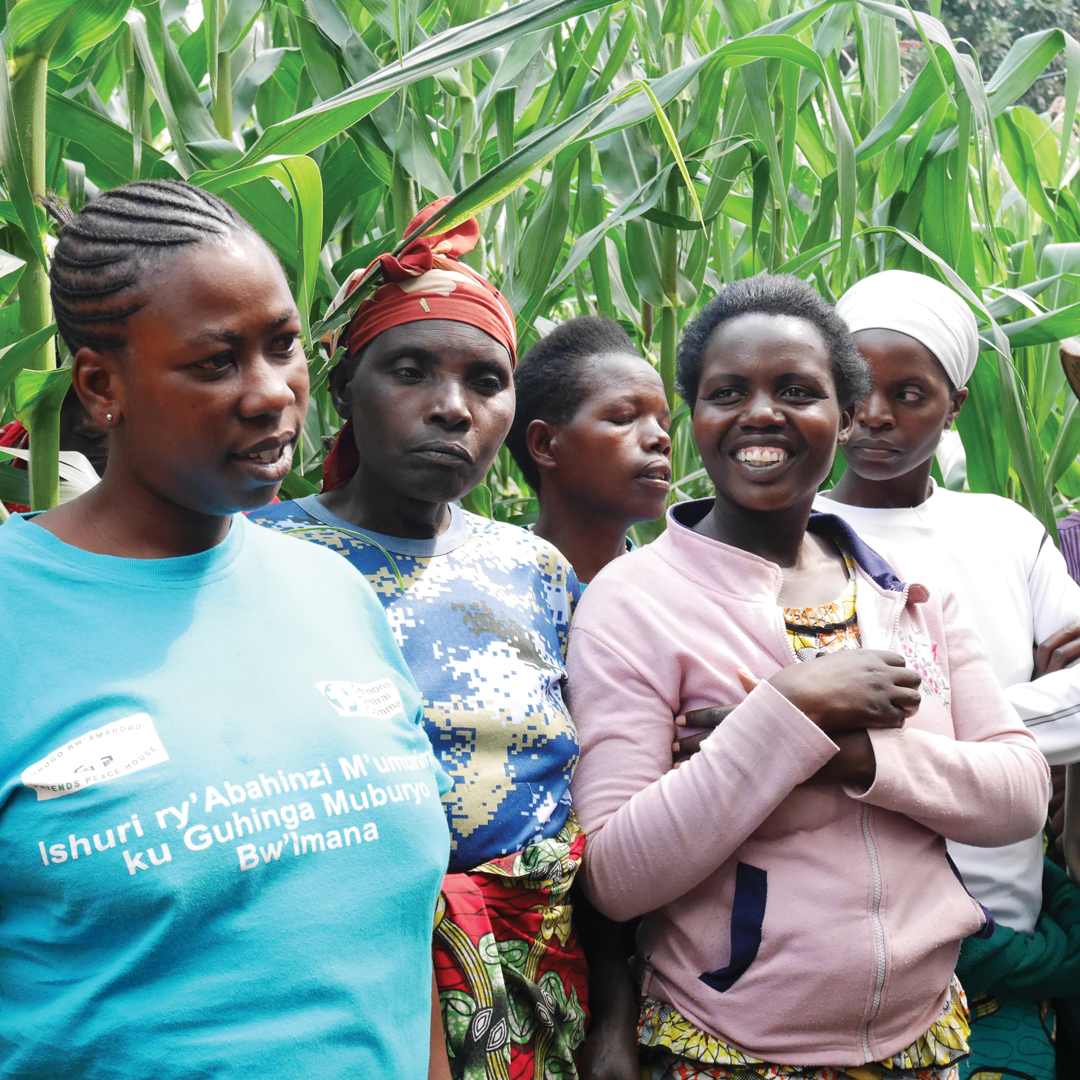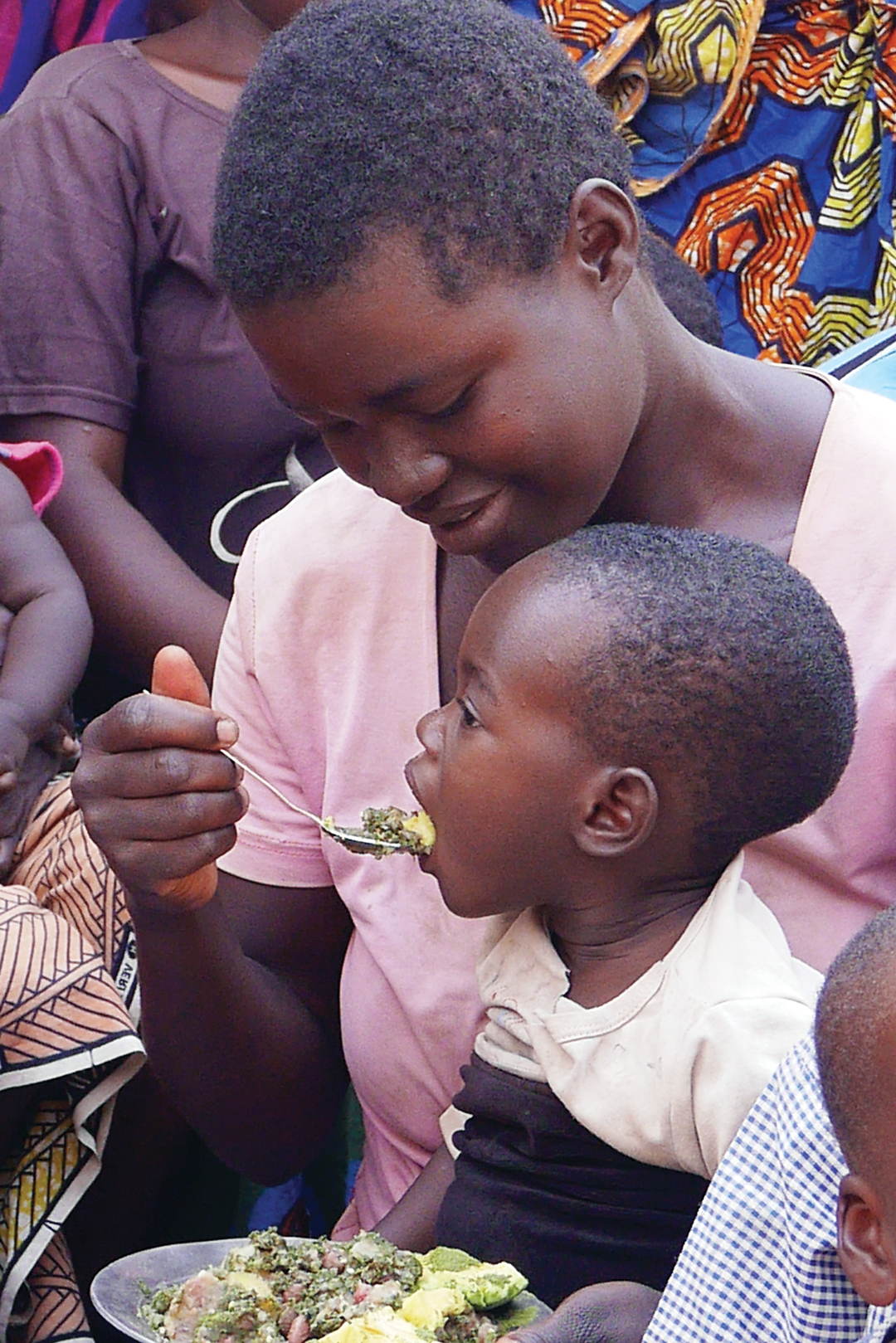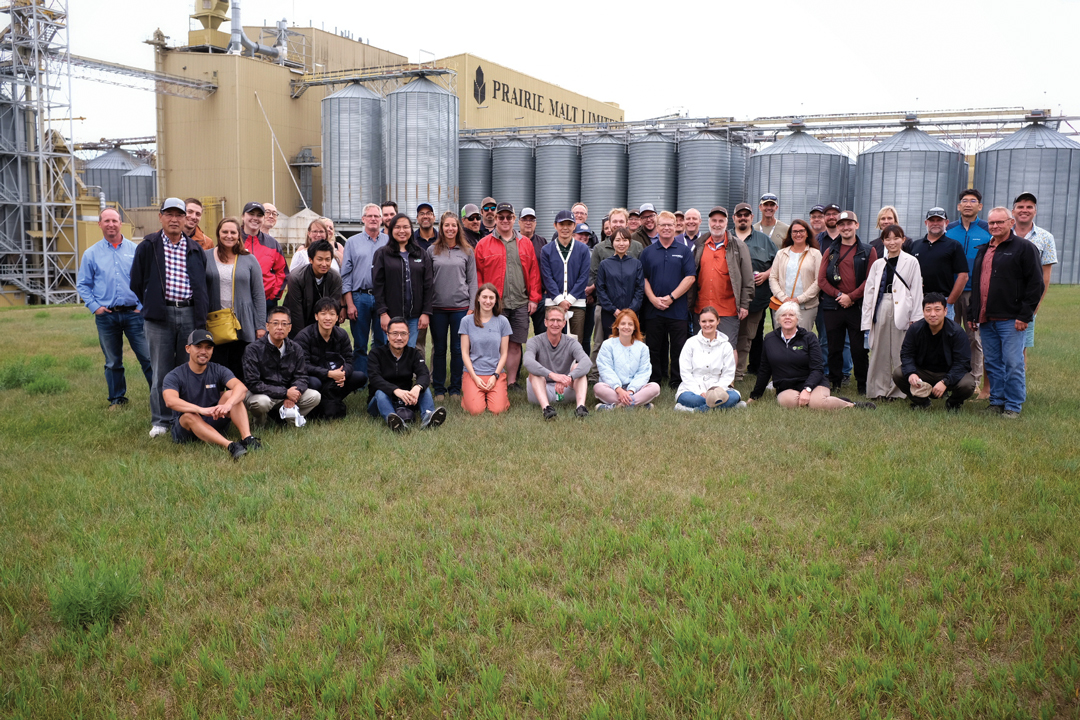SPREADING THE WEALTH
CANADIAN FOODGRAINS BANK CREATES A FARMING COMMUNITY
BY ALLISON FINNAMORE
Despite the 13,000 kilometres that separate Earl Jeninga’s home in Linden, AB, from rural farmers in Rwanda, he still feels a connection.
Jeninga and 11 other Canadians travelled to Rwanda in January to learn about projects supported by the Canadian Foodgrains Bank (CFGB) and to see where CFGB funds—which are primarily raised by Canadian farmers—are being put to work. According to the CFGB’s 2015/16 annual report, $551,940 was budgeted for Rwanda during that fiscal year, benefitting a forecasted 20,570 people through agriculture and livelihood assistance projects.
Most of the funds for Rwanda, and countries like it, come from CFGB growing projects like the one Jeninga leads in Linden, where a 300-acre rotation of wheat, barley and canola is grown, harvested and sold to the local community every year. This money can go a long way in a country like Rwanda, where many farmers could be more productive if given better equipment and growing methods.
“They’re trying to grow the best crop they possibly can with the tools that they have, and we’re trying to give them the tools,” said Jeninga, who also manages Kneehill Soil Services.
CFGB executive director Jim Cornelius said there’s a unity among farmers, whether the farms are located across the street from each other or on opposite sides of the globe. Many of the issues Canadian farmers face—from market forces to weather problems and everything in between—are familiar to their colleagues in other countries.
“There’s a way of feeling solidarity with other farmers,” Cornelius said. “They face a lot of similar issues but on a different scale.”
That connection is a vital cornerstone on which the foundation of the CFGB was built. The organization began in 1976 through the Mennonite Central Committee. Missionaries who travelled to African countries witnessed first-hand the food shortages residents faced, and came home resolved to help. The result was a pilot project that allowed Canadian grain farmers to share their harvests with those less fortunate around the world.
The group reorganized and expanded in 1983/84, just in time to make a significant contribution to fight the famine ravaging Ethiopia at the time. Today, the CFGB includes 15 church agencies representing 30 Canadian denominations and works to raise money for a number of projects, including agriculture and livelihood programs to teach farmers in developing countries how to best produce food on a long-term basis. The CFGB also spearheads food assistance projects to help people who are hungry because of crisis situations like war, drought or flooding. As well, its work now includes nutrition projects aimed at reducing malnutrition through education, provision of clean water and special feeding programs. Within Canada, the CFGB is an advocate for national and international public policy change to enable families and communities to better feed themselves.
MAKING A DIFFERENCE
In Rwanda, Jeninga saw first-hand the teaching programs that are partially funded by the CFGB, leaving him confident that growing project funds are being put to good use. He also had a valuable opportunity to learn from the Rwandan farmers.
A CFGB partnership with the Adventist Development and Relief Agency funds a farmer field school in the Ndego sector of Rwanda’s Eastern Province. The sector is located near the Ugandan border, and although it is only 120 kilometres north of Kigali, it takes about three hours to drive there from the Rwandan capital via the twisty roads of the Rwandan hillside.
The farmer field school teaches its roughly 30 members the tenets of conservation agriculture—such as moisture and soil preservation, and crop rotation. Odette Nzayisenga, the president of the farmer field school, explained that prior to the school’s creation two years ago, its current members had no agricultural skills and their approach to farming was random and unfocused. Since then, they’ve made significant improvements.
“We used to just till the land, not take care of the soils, and used to grow without measurement, just random plant space,” Nzayisenga said through an interpreter. “Now we measure and use proper fertilizer rations, we learned about crop rotation.”
For Jeninga, meeting the members of the farmer field school in Ndego was a great example of how the CFGB money is helping farmers around the world. What might seem like common agricultural practices to farmers in developed nations can often be small, yet critical, teachings that bring valuable skills to the fields of subsistence farmers in other countries.
“When you look at the kind of stuff being done on a small scale, you can see that what we’re doing is making a difference,” Jeninga said. “This confirms it.”
Solidifying that confirmation was a neighbouring farmer who stood on the fringes of the farm tour and listened to the farmer field school participants answering questions, then jumped into Canadian Foodgrains Bank by the numbers the conversation. Even though he wasn’t a participant in the learning program, he said he started asking the farmers questions when he saw their successful crops and implemented similar practices on his plot. Now, he said, smiling, his maize looks better than that of the field school participants.
Terence Barg, the CFGB’s northern Alberta representative, was also in Rwanda and has witnessed the organization’s impact in other countries. Each time he sees the CFGB’s work in action, the experience is affirming, he said.
“It’s always rewarding to see the success of projects,” Barg said. “It’s amazing to see how much of a difference it makes in these people’s lives in these areas where it’s very dry.”
HONOURING THE PAST, EMBRACING THE FUTURE
When most of us think of Rwanda, agriculture isn’t typically the first image that springs to mind.
Instead, our thoughts probably jump to the 1994 Rwanda genocide, when racial tensions boiled over and Hutu extremists viciously killed an estimated 500,000 to 1.3 million Tutsi and moderate Hutus between April and July of that year.
The country continues to heal from the genocide, and extensive reconciliation and peacemaking is part of everyday life. Even in farmer training programs, funded in part by the CFGB, peacemaking is taught.
The farmer training programs were one element of the CFGB’s impact in Rwanda witnessed by the 12 visiting Canadians, who included journalists, CFGB staff and Canadian farmers.
As the Canadian visitors grappled with the country’s horror-filled past, Rwandans met with the group and patiently answered all the questions that arose. As the days passed and the Canadian group found its footing, what became clear was the spirit of reconciliation that characterizes the country today. Through numerous, deliberate peacemaking steps taken every day, Rwandans demonstrate their decision to forgive. They choose to look ahead and build a unified future rather than dwell on the horrors of 1994.
The CFGB assistance efforts the Canadians witnessed provided simple solutions to common problems and are highly effective at helping farmers in need.
In the Kirehe district of Rwanda’s Eastern Province, 1,329 homes participate in a CFGB project partnership with the Canadian Baptist Ministries. The Canadian visitors met several farmers in the village, including Athanase Nsengiyumva, who, like many Rwandan farmers, grows vegetables in his backyard—including cabbage, carrots, green peppers, celery and red onions—and sells them at the market. Like the other farmers, Nsengiyumva sometimes struggles to have enough water for his garden, but he’s one of 181 residents who received funding to install a rain basin that collects water throughout the year. He proudly showed the group his store of water, which he said allows him to get almost all the way through the dry season and keep his garden growing.
“There is a dream that the vegetables could be available throughout the year if there is water,” he said.
Most striking about the rain basin was the cost—about 106,000 Rwandan francs, the equivalent of roughly CAD$170. It represents such a simple solution to a serious problem and made a huge difference for Nsengiyumva, but at that price, it is out of reach for most Rwandan farmers without financial assistance.
While in Eastern Rwanda, the group also saw a straightforward watering system that the CFGB helped fund in partnership with the Mennonite Central Committee (MCC). The Canadians saw how 20-litre, unglazed pots were buried in gardens then filled with water. As the soil requires moisture, it draws it from the pot. The pots are refilled a couple of times a week—a major savings of labour when the closest water source is a lake located a mile away, where water needs to be drawn and carried back to one’s home and garden by hand.
Hygiene is another issue tackled through the CFGB partnerships in simple and straightforward ways. Through the partnerships between the CFGB and the MCC, Rwandans are taught the utility of having a proper latrine located away from the house and any food sources, and the importance of washing their hands after using the latrine.
The addition of nutrients to certain foods to make up for any deficiencies in one’s regular diet is commonplace in Canada, but in Rwanda this was new information. The Moringa tree—a fast-growing, drought-resistant species—has leaves that are basically a superfood, containing large quantities of several vital nutrients. Residents in this Eastern Rwanda village now grind the leaves and sprinkle them over food for a nutritional boost.
In the fields, the partnerships the CFGB has with other aid organizations have taught Rwandan farmers how to preserve soil moisture, deal with soil erosion and plant nutrient-dense foods in their backyard gardens.
Rwanda, which refers to itself as the land of a thousand hills and a million smiles, left a lasting impression on Jeninga. He recalled the Rwandan farmers’ warm greetings, unbridled openness and willingness to answer questions from a group of Canadians as memories that he’ll keep from the visit.
“The beautiful landscape will stick with me,” Jeninga said. “But even more so is how accepting these farmers and these families were of us coming here. They were inviting and proud of their plots, and welcomed us into their homes. That’s what will stick with me.”
CANADIAN FOODGRAINS BANK BY THE NUMBERS
According to the Canadian Foodgrains Bank’s (CFGB) annual report, in 2015/16, it provided $43 million of assistance for more than one million people in 40 countries through 133 unique projects.
Donations over the same time period reached $11.3 million, while member agencies contributed another $4.8 million. Land donations reached a value of $755,236.
Donations came from individuals, church congregations, companies and 268 growing and community projects, where crops are grown, cared for, harvested and sold, with the profits donated back to the CFGB.
Global Affairs Canada funding totalling $32.5 million is also recorded as income by the CFGB for 2015/16. According to the CFGB’s annual report, it received three grants from the department: a five-year core grant signed in 2011, a special grant for aid to displaced Syrians within their own country and a multiyear, $14-million conservation agriculture grant. A further $480,000 was received from the Bill & Melinda Gates Foundation.
In terms of expenses, the CFGB spent $47 million on international program activities to provide and distribute food, and support agriculture livelihood and nutrition programs.









Comments